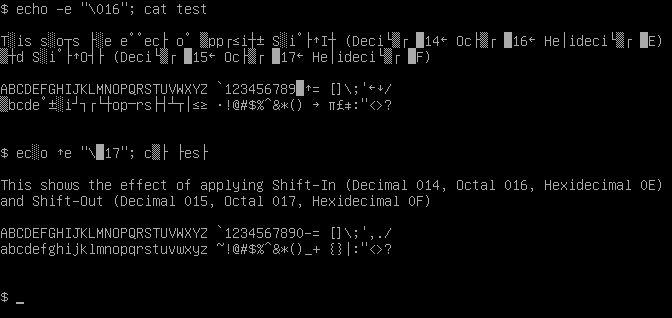Shift In on:
[Wikipedia]
[Google]
[Amazon]
 Shift Out (SO) and Shift In (SI) are
Shift Out (SO) and Shift In (SI) are
 Shift Out (SO) and Shift In (SI) are
Shift Out (SO) and Shift In (SI) are ASCII
ASCII ( ), an acronym for American Standard Code for Information Interchange, is a character encoding standard for representing a particular set of 95 (English language focused) printable character, printable and 33 control character, control c ...
control character
In computing and telecommunications, a control character or non-printing character (NPC) is a code point in a character encoding, character set that does not represent a written Character (computing), character or symbol. They are used as in-ba ...
s 14 and 15, respectively (0x0E and 0x0F). These are sometimes also called "Control-N" and "Control-O".
The original purpose of these characters was to provide a way to shift a coloured ribbon, split longitudinally usually with red and black, up and down to the other colour in an electro-mechanical typewriter
A typewriter is a Machine, mechanical or electromechanical machine for typing characters. Typically, a typewriter has an array of Button (control), keys, and each one causes a different single character to be produced on paper by striking an i ...
or teleprinter
A teleprinter (teletypewriter, teletype or TTY) is an electromechanical device that can be used to send and receive typed messages through various communications channels, in both point-to-point (telecommunications), point-to-point and point- ...
, such as the Teletype
A teleprinter (teletypewriter, teletype or TTY) is an electromechanical device that can be used to send and receive typed messages through various communications channels, in both point-to-point and point-to-multipoint configurations.
Init ...
Model 38, to automate the same function of manual typewriters. Black was the conventional ambient default colour and so was shifted "in" or "out" with the other colour on the ribbon.
Later advancements in technology instigated use of this function for switching to a different font
In metal typesetting, a font is a particular size, weight and style of a ''typeface'', defined as the set of fonts that share an overall design.
For instance, the typeface Bauer Bodoni (shown in the figure) includes fonts " Roman" (or "regul ...
or character set
Character encoding is the process of assigning numbers to graphical characters, especially the written characters of human language, allowing them to be stored, transmitted, and transformed using computers. The numerical values that make up a c ...
and back. This was used, for instance, in the Russian character set known as KOI7-switched, where SO starts printing Russian letters, and SI starts printing Latin letters again. Similarly, they are used for switching between Katakana
is a Japanese syllabary, one component of the Japanese writing system along with hiragana, kanji and in some cases the Latin script (known as rōmaji).
The word ''katakana'' means "fragmentary kana", as the katakana characters are derived fr ...
and Roman letters in the 7-bit version of the Japanese JIS X 0201
JIS X 0201, a Japanese Industrial Standards, Japanese Industrial Standard developed in 1969, was the first Japanese electronic character set to become widely used. The character set was initially known as JIS C 6220 before the JIS category reform. ...
.
SO/SI control characters also are used to display VT100
The VT100 is a video terminal, introduced in August 1978 by Digital Equipment Corporation (DEC). It was one of the first terminals to support ANSI escape codes for cursor control and other tasks, and added a number of extended codes for special ...
pseudographics. Shift In is also used in the 2G variant of SoftBank Mobile's encoding for emoji
An emoji ( ; plural emoji or emojis; , ) is a pictogram, logogram, ideogram, or smiley embedded in text and used in electronic messages and web pages. The primary function of modern emoji is to fill in emotional cues otherwise missing from type ...
.
The ISO/IEC 2022 standard ( ECMA-35, JIS X 0202) standardises the generalized usage of SO and SI for switching between pre-designated character sets invoked over the 0x20–0x7F byte range. It refers to them respectively as Locking Shift One (LS1) and Locking Shift Zero (LS0) in an 8-bit environment, or as SO and SI in a 7-bit environment. In ISO-2022-compliant code sets where the 0x0E and 0x0F characters are used for the purpose of emphasis (such as an italic or red font) rather than a change of character set, they are referred to respectively as Upper Rail (UR) and Lower Rail (LR), rather than SO and SI.
See also
*C0 and C1 control codes
The C0 and C1 control code or control character sets define control codes for use in text by computer systems that use ASCII and derivatives of ASCII. The codes represent additional information about the text, such as the position of a cursor, ...
References
{{Reflist Control characters